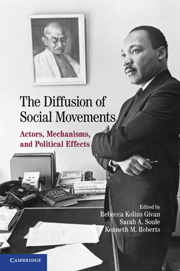Book contents
- Frontmatter
- Contents
- List of Tables
- List of Figures
- Contributors
- Preface and Acknowledgments
- 1 Introduction: The Dimensions of Diffusion
- PART I DIFFUSION AND THE FRAMING OF CONTENTIOUS POLITICS
- 2 Transnational Networks and Institutions: How Diffusion Shaped the Politicization of Sexual Harassment in Europe
- 3 Temporality and Frame Diffusion: The Case of the Creationist/Intelligent Design and Evolutionist Movements from 1925 to 2005
- 4 Framing Labor's New Human Rights Movement
- 5 Framing the GMO: Epistemic Brokers, Authoritative Knowledge, and Diffusion of Opposition to Biotechnology
- PART II MECHANISMS OF DIFFUSION
- PART III DIFFUSION, SCALE SHIFT, AND ORGANIZATIONAL CHANGE
- General Bibliography
- Index
2 - Transnational Networks and Institutions: How Diffusion Shaped the Politicization of Sexual Harassment in Europe
Published online by Cambridge University Press: 05 June 2012
- Frontmatter
- Contents
- List of Tables
- List of Figures
- Contributors
- Preface and Acknowledgments
- 1 Introduction: The Dimensions of Diffusion
- PART I DIFFUSION AND THE FRAMING OF CONTENTIOUS POLITICS
- 2 Transnational Networks and Institutions: How Diffusion Shaped the Politicization of Sexual Harassment in Europe
- 3 Temporality and Frame Diffusion: The Case of the Creationist/Intelligent Design and Evolutionist Movements from 1925 to 2005
- 4 Framing Labor's New Human Rights Movement
- 5 Framing the GMO: Epistemic Brokers, Authoritative Knowledge, and Diffusion of Opposition to Biotechnology
- PART II MECHANISMS OF DIFFUSION
- PART III DIFFUSION, SCALE SHIFT, AND ORGANIZATIONAL CHANGE
- General Bibliography
- Index
Summary
Diffusion is often conceptualized as a random, voluntary, almost “natural” process, which is reflected in synonyms such as “contagion,” “spread,” or “flow.” In this chapter, instead, I want to draw attention to diffusion as a strategic process and highlight the crucial role of “framing” in this. In line with Schneiberg and Soule (2004), I see diffusion as a political process in which actors at different levels (strategically) adopt and adapt foreign examples to make national and transnational claims and to change institutional and legal settings, build alliances, and exert pressure. Institutional encounters affect the framing of social movements (see Tarrow, Chapter 11). To get their message across, social movements must adapt their frames and align them to the dominant frames of other relevant actors. Strategic framing efforts are thus central in shaping this political process and, as I will demonstrate in this chapter, are crucial in allocating power and positions in this process.
In recent decades, social scientists have been paying increasing attention to the central role of diffusion in shaping social movements, policies, and institutions (see also Chapter 1 of this volume). Examples of these are studies of democratization, the globalization of the human rights discourse, and transnational mobilizations that demonstrate convergence not only of strategies, ideas, and slogans, but also of policies and legislation. These studies, however, provide us with little insight into how these processes occur and into the intracountry dynamics.
- Type
- Chapter
- Information
- The Diffusion of Social MovementsActors, Mechanisms, and Political Effects, pp. 19 - 33Publisher: Cambridge University PressPrint publication year: 2010
- 10
- Cited by

